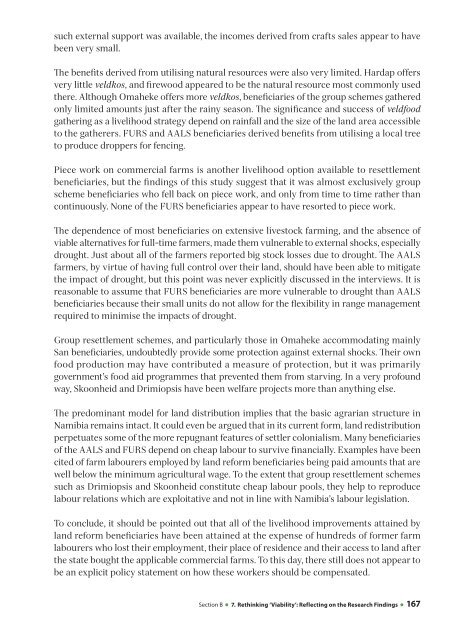Namibia country report
Namibia country report
Namibia country report
- No tags were found...
You also want an ePaper? Increase the reach of your titles
YUMPU automatically turns print PDFs into web optimized ePapers that Google loves.
such external support was available, the incomes derived from crafts sales appear to havebeen very small.The benefits derived from utilising natural resources were also very limited. Hardap offersvery little veldkos, and firewood appeared to be the natural resource most commonly usedthere. Although Omaheke offers more veldkos, beneficiaries of the group schemes gatheredonly limited amounts just after the rainy season. The significance and success of veldfoodgathering as a livelihood strategy depend on rainfall and the size of the land area accessibleto the gatherers. FURS and AALS beneficiaries derived benefits from utilising a local treeto produce droppers for fencing.Piece work on commercial farms is another livelihood option available to resettlementbeneficiaries, but the findings of this study suggest that it was almost exclusively groupscheme beneficiaries who fell back on piece work, and only from time to time rather thancontinuously. None of the FURS beneficiaries appear to have resorted to piece work.The dependence of most beneficiaries on extensive livestock farming, and the absence ofviable alternatives for full-time farmers, made them vulnerable to external shocks, especiallydrought. Just about all of the farmers <strong>report</strong>ed big stock losses due to drought. The AALSfarmers, by virtue of having full control over their land, should have been able to mitigatethe impact of drought, but this point was never explicitly discussed in the interviews. It isreasonable to assume that FURS beneficiaries are more vulnerable to drought than AALSbeneficiaries because their small units do not allow for the flexibility in range managementrequired to minimise the impacts of drought.Group resettlement schemes, and particularly those in Omaheke accommodating mainlySan beneficiaries, undoubtedly provide some protection against external shocks. Their ownfood production may have contributed a measure of protection, but it was primarilygovernment’s food aid programmes that prevented them from starving. In a very profoundway, Skoonheid and Drimiopsis have been welfare projects more than anything else.The predominant model for land distribution implies that the basic agrarian structure in<strong>Namibia</strong> remains intact. It could even be argued that in its current form, land redistributionperpetuates some of the more repugnant features of settler colonialism. Many beneficiariesof the AALS and FURS depend on cheap labour to survive financially. Examples have beencited of farm labourers employed by land reform beneficiaries being paid amounts that arewell below the minimum agricultural wage. To the extent that group resettlement schemessuch as Drimiopsis and Skoonheid constitute cheap labour pools, they help to reproducelabour relations which are exploitative and not in line with <strong>Namibia</strong>’s labour legislation.To conclude, it should be pointed out that all of the livelihood improvements attained byland reform beneficiaries have been attained at the expense of hundreds of former farmlabourers who lost their employment, their place of residence and their access to land afterthe state bought the applicable commercial farms. To this day, there still does not appear tobe an explicit policy statement on how these workers should be compensated.Section B ● 7. Livelihoods Rethinking ‘Viability’: after Land Reform: Reflecting <strong>Namibia</strong> on the <strong>country</strong> Research <strong>report</strong> Findings (2010) ● 167
















